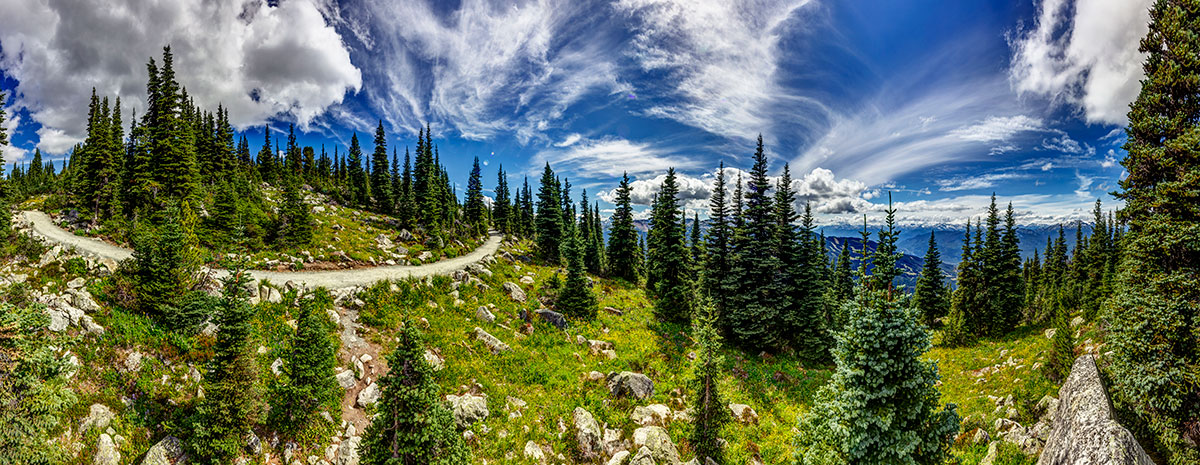WHISTLER
Welcome to Sea to Sky Country
By David Burke / Images By Joern Rohde

Ah, summer in the mountains: afternoons by the lake, hiking in the alpine, a barbecue and drinks on the patio … what could top that? And what place could be better than Whistler to enjoy it all — less than 90 minutes from Vancouver, with more options for dining, shopping, arts and culture, and outdoor adventure than any other mountain town in North America?
Whistler is best known for its skiing and snowboarding and as the Host Mountain Resort for the 2010 Winter Olympics and Paralympics, but many have opined that summer is their favourite time of year in the resort. Given that it’s also home to the world-leading Whistler Mountain Bike Park and an extensive and well-maintained trail network for biking, hiking and running, its vibrant arts scene, the record-setting Peak 2 Peak Gondola and incomparable golf courses, that’s not at all surprising. Even if you’re not an adrenaline junkie, there’s so much here: from four top-ranked golf courses to outdoor summertime concerts to people watching in the Village to world-class dining to top-flight museums and galleries.
For centuries, the Whistler Valley was hunting and berry-picking territory for the Squamish and Lil’wat peoples. The first European fur trappers, loggers and miners arrived in the late 1800s. In 1914, the same year the Pacific Great Eastern Railway arrived, Myrtle and Alex Philip put the community (then known as Alta Lake) on the tourism map when they opened Rainbow Lodge, a summertime fishing establishment that quickly caught on with visitors from across Canada.


Inspired by the success of the 1960 Winter Olympics in Squaw Valley, Calif., Franz Wilhelmsen and his business partners arrived in 1960 with a vision to make what was then known as London Mountain the host mountain for the 1968 Games. With a name change to Whistler Mountain, the ski hill opened in 1966, but the Olympic dream didn’t come to fruition until 2003 when Vancouver and Whistler were chosen to host the 2010 Games. Vestiges of Whistler’s Olympic legacy are around town, with several sets of Olympic rings and “Inukshuks” — stylized Inuit rock cairns that served as the “welcome” symbol of the Games.
Whistler Olympic Plaza, where medal ceremonies took place during the 2010 Olympics and Paralympics, is a great place to pull out the Frisbee and enjoy a picnic or a drink purchased from a nearby café in the shadow of the Olympic rings. At Whistler Olympic Park, 15 kilometres from the Village in the Callaghan Valley, you can hike to the top of the ski jumps or shoot a biathlon rifle at the venue that hosted cross-country skiing, ski jumping, Nordic combined and biathlon during the Games.
At the Whistler Sliding Centre, near the Village, you can experience the exhilaration of the world’s fastest bobsleigh track, summertime edition. On Saturdays and Sundays in July and August, guests can take a run down the track at speeds up to 90 km/h (55 mi/h) on wheeled sleds. You can also take a free, self-guided tour of the facility. For info on Whistler Olympic Park or the Whistler Sliding Centre. whistlersportlegacies.com

Whistler Blackcomb (WB) has recently added new on-mountain attractions. The 2019 opening of the Blackcomb Gondola gave WB the distinction of having the first world’s first three-gondola lift connection. It allowed visitors to ascend either the Whistler or Blackcomb gondola, cross over on the Peak 2 Peak Gondola and descend back to the valley floor without riding the same conveyance twice. Avid hikers can also enjoy a great workout on the Blackcomb Ascent Trail — three interconnected trails that ascend through coastal forests from the valley bottom to either the gondola mid-station or 1,200 vertical metres (3,937 feet) to the Rendezvous Lodge. From there, guests can ride back down in climate-controlled comfort.
The world-leading Whistler Mountain Bike Park is open for adrenaline-fuelled summer riding, giving riders access to the varying array of trails accessed by the Fitzsimmons Express, Garbanzo Express, and Creekside-area lifts through Oct.12. whistlerblackcomb.com

Lovers of great art are gravitating to Whistler. In addition to the impressive selection of private galleries, the Audain Art Museum, which opened in 2016, features artworks by renowned Canadian artists, including Emily Carr and E.J. Hughes. Visitors can also learn about local First Nations and their vibrant cultures at the world-class Squamish Lil’wat Cultural Centre (SLCC). You can also take the self-guided “Cultural Connector” walk that stops at the SLCC, Lost Lake PassivHaus, the Audain Art Museum, the Maury Young Arts Centre, the Whistler Public Library and the Whistler Museum and Archives. Along the route, you’ll find myriad pieces of stunning public art, including “Thunderbird” by Squamish Nation artist Sinámkin (Jody Broomfield) and “A Timeless Circle” by Musqueam artist Susan Point.
Whistler has a dining and nightlife experience for every occasion, with a vast array of restaurants, pubs and patios. Whether it’s relaxation or thrills you’re seeking, there’s no shortage of opportunities for summertime enjoyment here. Welcome!
For assistance in planning your trip, visit Tourism Whistler (whistler.com) or whistlertraveller.com.

